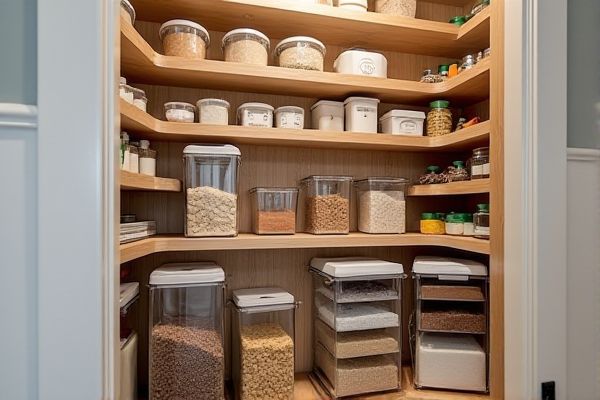
Gravity bins provide easy access to bulk dry goods with a self-feeding mechanism that keeps items fresh and visible, while stackable bins maximize vertical space and offer customizable organization for various pantry items. Discover which option best suits Your kitchen needs by exploring the detailed comparison in the rest of this article.
Table of Comparison
| Feature | Gravity Bins | Stackable Bins (Pantry) |
|---|---|---|
| Design | Slanted interior with gravity feed for easy dispensing | Flat, stackable units for organized storage |
| Accessibility | One-handed, quick access with push lever or front opening | Manual access by lifting or opening lids |
| Space Efficiency | Optimized for countertop or shelf usage with gravity angled design | Maximizes vertical space by stacking |
| Usage | Ideal for dry goods like cereals, grains, pet food | Suitable for various pantry items including jars, snacks, bulk foods |
| Refill & Cleaning | Easy refill from top; simple to clean | Removable lids and compartments facilitate cleaning |
| Cost | Generally higher due to mechanical parts | Usually more affordable and simpler |
| Durability | Durable with plastic or acrylic build; mechanical parts may wear | Robust stacks; less mechanical failure risk |
Introduction to Pantry Storage Solutions
Pantry storage solutions include gravity bins and stackable bins, each offering unique organizational benefits. Gravity bins utilize a tilted design that allows items to automatically move forward, promoting first-in, first-out inventory management ideal for dry goods. Stackable bins maximize vertical space, providing customizable compartments that are easy to access and arrange for efficient pantry organization.
What Are Gravity Bins?
Gravity bins are designed with sloped floors to allow products to gently roll forward for easy access and automatic restocking, making them ideal for bulk pantry storage. Unlike stackable bins, which require manual retrieval and refilling, gravity bins ensure first-in, first-out inventory rotation, reducing waste. Your pantry organization benefits from improved efficiency and convenience by incorporating gravity bins.
What Are Stackable Bins?
Stackable bins are modular storage containers designed to be securely stacked vertically, maximizing pantry space efficiency while maintaining easy accessibility. Made from durable materials like clear plastic or reinforced acrylic, these bins allow users to quickly identify contents and organize items by category or size. Unlike gravity bins that automatically dispense items through a front opening, stackable bins require manual access, making them ideal for storing bulkier pantry goods or items that do not flow easily.
Space Efficiency: Gravity Bins vs Stackable Bins
Gravity bins maximize space efficiency by utilizing angled compartments that dispense contents automatically, reducing the need for extra room to access items. Stackable bins optimize vertical space by allowing multiple containers to be securely piled, making them ideal for smaller pantries with limited floor area. Both solutions enhance organization, but gravity bins often save more time and countertop space due to their ergonomic design.
Accessibility and Ease of Use
Gravity bins offer superior accessibility through a front-facing gravity-fed design that automatically dispenses items, reducing the need to reach into the back of the pantry. Stackable bins maximize vertical space but often require lifting or rearranging to access items stored below, making them less convenient for frequent use. Your choice depends on whether quick, hands-free access or maximizing storage density is a higher priority in your pantry organization.
Food Freshness and Preservation
Gravity bins enhance food freshness and preservation by providing controlled dispensing that minimizes exposure to air, reducing oxidation and contamination. Stackable bins, while space-efficient, often require manual handling that can expose ingredients to humidity and pests, potentially decreasing shelf life. Using gravity bins in pantries helps maintain optimal freshness by limiting interaction with external elements.
Organization and Visibility
Gravity bins enhance organization by automatically rotating items to the front, ensuring first-in-first-out usage and reducing food waste. Stackable bins maximize vertical space in pantries, allowing clear categorization and easy access through transparent materials. Combining both types can optimize pantry visibility and streamline inventory management.
Cleaning and Maintenance
Gravity bins simplify cleaning and maintenance due to their smooth surfaces and minimal crevices, allowing easy wiping and quick removal of residue. Stackable bins often require disassembly for thorough cleaning, especially when food particles get trapped between bins. Materials like BPA-free plastic in both options resist staining and odor retention, but gravity bins' design minimizes buildup, reducing maintenance efforts.
Cost Comparison: Gravity Bins vs Stackable Bins
Gravity bins generally have a higher upfront cost compared to stackable bins due to their advanced dispensing mechanism and durable materials. Stackable bins offer a more budget-friendly option with simple design and easier customization, making them ideal for larger pantry setups on a tight budget. Your choice depends on balancing initial investment with long-term convenience and space optimization needs.
Which Bin is Best for Your Pantry Needs?
Gravity bins offer quick access and automatic product rotation, ideal for frequently used pantry items and bulk storage, while stackable bins maximize vertical space and provide customizable organization for smaller or varied items. Gravity bins are best for maintaining freshness and reducing waste, whereas stackable bins excel in flexibility and easy labeling. Choosing the right bin depends on your pantry size, item types, and how often you access stored goods.
 homyna.com
homyna.com